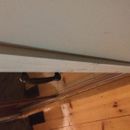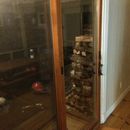Insulating curtains for a sliding glass door?
I have a large two-pane sliding glass door in my den (same room as my woodstove). While it provides nice views during our 10 hours of winter daylight, it just loses heat during the 14 hours of darkness. My IR gun indicates 10-15 degrees of temperature difference, compared to the exterior siding.
I see lots of insulating curtains on the market, but most seem like they would create a convective loop due to not sealing around the edges. I would want to seal the curtains against the door frame, at least across the top and bottom, and even better, all around the perimeter. Is there a product out there for this purpose, with insulating properties in mind (rather than avoiding solar gain?)
GBA Detail Library
A collection of one thousand construction details organized by climate and house part












Replies
Tyler,
A high quality interior window quilt or insulating shade system is likely to be expensive and probably isn't cost-effective -- but adding such a quilt will make you more comfortable.
Here is a link to an article by Marc Rosenbaum on cellular shades: Insulating Window Shades.
Here is a link to the Window Quilt company.
Thanks Martin. I'm confused by the comments on that thread about condensation on the backside of the drapes. If the perimeter seal really worked as advertised, where would the warm moist air be coming from to contact the cold glass?
Tyler,
First of all, neither a window quilt nor insulating shades are truly airtight, so I'm sure that there is some convective looping and air exchange between the interior of the home and the air pocket behind the shades.
Most important, the air that is trapped behind the shades is indoor air -- that is, warm, humid air. When the glass cools off, the moisture in that air condenses on cold surfaces.
I made a custom insulated rollup shade for a large picture window, using a special insulating fabric. I did not follow recommendations to sew in a magnetic seal on the jambs and sill and I did get a lot of condensation (zone 5). Otherwise it worked well. I have also cut foam insulation to fit the opening of an older sliding glass door. I left the fixed panel covered all winter. That worked fairly well, however I used EPS and had a lot of condensation. It may work if you remove the foam every day or use XPS. Of course you have to put it somewhere when it's not in place..
There are some good ideas and links on builditsolar here http://www.builditsolar.com/Projects/Conservation/conservation.htm#WindowTreatments, I found the http://www.kumeproject.com site interesting - it shows how to make them and gets at the condensation _through_ the curtain with a vapor barrier. I also found the http://www.warmcompany.com site had some interesting how-to info, particularly the info on using magnetic tape strips to seal at the perimeter of the drape.
I think the key takeaways are insulating material such as fleece or batting, a vapor barrier, and magnetic tape strips along the perimeter to hold the top & sides (and possibly where two panels meet of the drape to the trim.
I can see how one would operate a roman shade with the magnets. I'm a little less sure you'd make a draw-to-the-side drape over a slider work, particularly the fan-fold at the top. Maybe a valance could be made to seal the top reasonably well.
No affiliation with any of the above, but have been thinking along these lines for ways to improve the nighttime thermal efficiency of our sliders and windows with something that looks nice.
Bi-fold door/s made using rigid foam, paint it pretty or cover in fabric or use duct tape to make hinge, fit snuggly, friction fit, in the door jamb and cut to form and lock into door handle.....